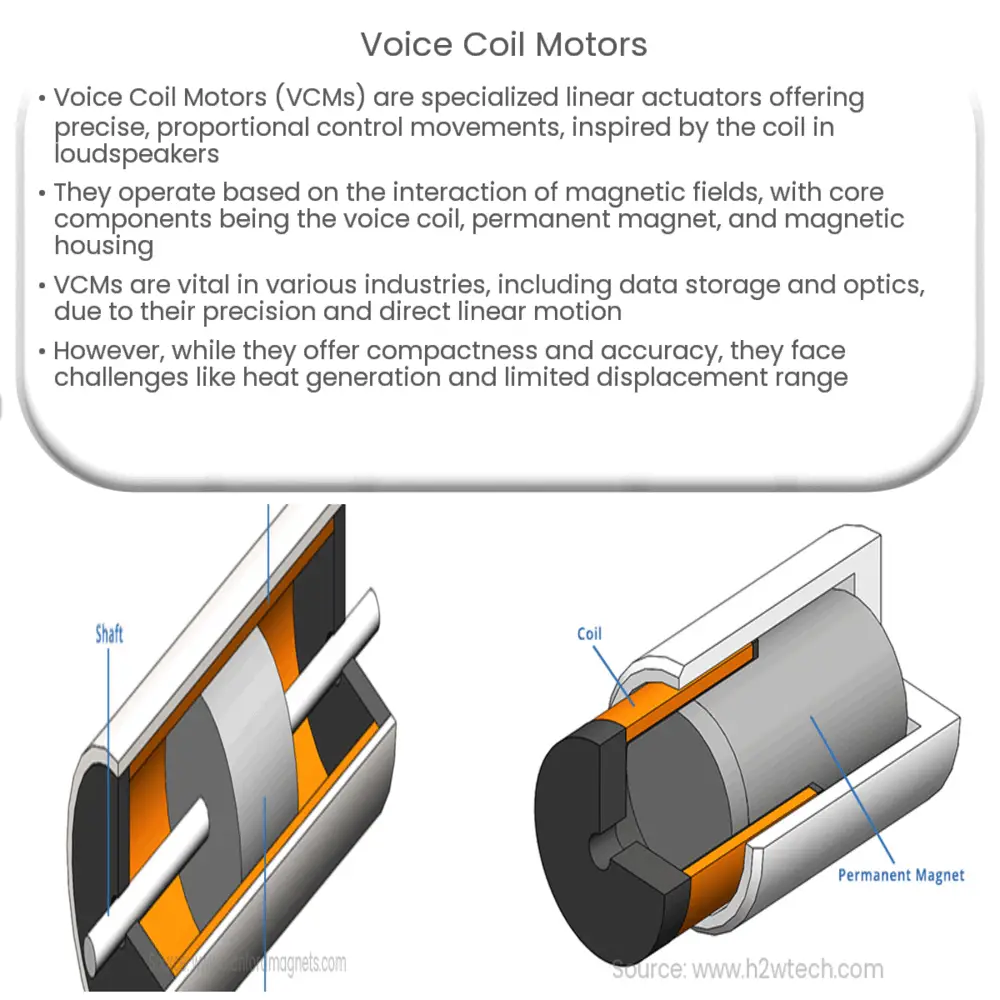Explore the working principle, components, applications, and pros & cons of Voice Coil Motors in this detailed guide.

Understanding Voice Coil Motors
A Voice Coil Motor (VCM) is a specialized form of linear actuator, primarily designed to provide highly precise, proportional control movements. Named after the coil in loudspeakers, which operates under similar principles, VCMs find use in numerous applications, ranging from hard disk drives to auto-focus mechanisms in cameras.
Working Principle of VCMs
The basic working principle of a voice coil motor centers around the interaction between magnetic fields. The VCM consists of a magnet and a coil within the magnet’s magnetic field. When current passes through the coil, it generates a magnetic field that interacts with the magnet’s field. The resulting force, obeying the Lorentz Law, propels the coil linearly, which, in turn, moves the attached load.
- Linear Movement: As opposed to rotational motors, VCMs are designed for direct linear motion. This quality is instrumental in applications where precise linear displacement is required, thereby eliminating the need for complex mechanical linkages that convert rotational motion to linear motion.
- Proportional Control: The motion of a VCM is proportional to the applied current, allowing for fine-tuned control of the motor’s movement.
Key Components of Voice Coil Motors
VCMs typically comprise three core components: the voice coil, the permanent magnet, and the magnetic housing.
- Voice Coil: This is a wound coil of wire designed to produce a magnetic field when electric current is applied. It acts as the moving part of the motor.
- Permanent Magnet: A fixed magnet providing a stable magnetic field in which the voice coil operates. Depending on the design, this can either be a single magnet or an array of magnets.
- Magnetic Housing: The magnetic housing, often made from ferromagnetic materials, acts as a return path for the magnetic field, ensuring efficient operation of the motor.
Together, these components form the basis of the VCM’s operation, facilitating its unique characteristics and wide range of applications.
Applications of Voice Coil Motors
VCMs are versatile and find applications in a multitude of industries due to their highly precise control and direct linear motion.
- Data Storage: In hard disk drives, voice coil motors are responsible for moving the read/write head. The precision and speed of a VCM ensure rapid access to data stored on the disk.
- Optical Instruments: In cameras, particularly in auto-focus mechanisms, VCMs adjust the lens position with high precision to maintain sharp image quality.
- Medical Applications: Medical devices such as ventilators and infusion pumps also utilize VCMs to control fluid movement with high precision.
- Robotics and Industrial Automation: VCMs find usage in robotics and automation where precision, quick response, and smooth control are paramount.
Advantages and Disadvantages of Voice Coil Motors
Like any other technology, VCMs also come with their set of pros and cons.
- Advantages: VCMs are compact, lightweight, and offer excellent positional accuracy. They are hysteresis-free, allowing for smooth control. Furthermore, they possess a simple design with minimal moving parts, reducing maintenance needs.
- Disadvantages: One significant drawback is heat generation due to the coil resistance. Excessive heat can lead to performance degradation or, in severe cases, failure. Also, VCMs provide limited displacement, which restricts their usage in applications requiring long-range movements.
Conclusion
In conclusion, Voice Coil Motors serve as critical components in various applications demanding precise linear movement. The principles of magnetic field interaction, linear displacement, and proportional control underscore their operation. Though challenged by issues such as heat generation and limited displacement, the benefits of VCMs – compactness, precision, and smooth control – make them indispensable in numerous sectors like data storage, optics, medical, and industrial automation. As technology advances, we can anticipate further improvements and applications of VCMs, reinforcing their importance in the realm of precision actuation.

